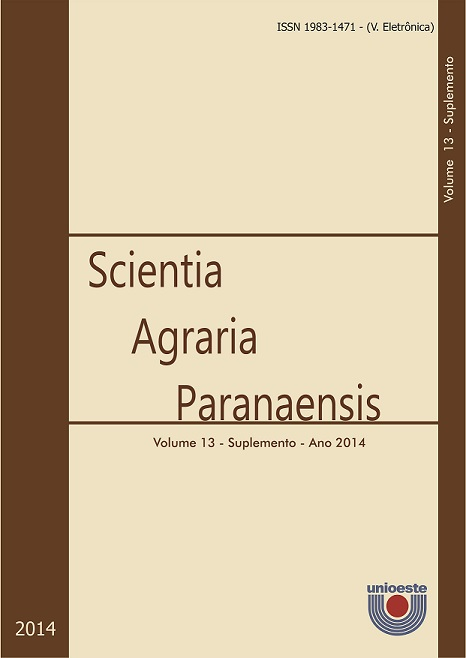Identificação de Alil Isotiocianato em crambe por HPLC
DOI:
https://doi.org/10.18188/sap.v13i0.11174Palavras-chave:
Crambe abyssinica Hochst, glicosinolato, cromatografiaResumo
A identificação de moléculas presentes nas plantas por meio de técnicas cromatográficas como HPLC, podem trazer resultados promissores para o controle alternativo de doenças, uma vez que brássicas apresentam glicosinolatos, que atuam na defesa das plantas. O objetivo deste trabalho foi verificar a presença de alil isotiocianato por meio de HPLC (cromatografia líquida de alta performance de fase reversa), através de diferentes métodos de extração. Foram utilizadas folhas de Crambe abyssinica, secas em estufa a 45 °C por 48 h. Os métodos de extração consistiram em utilizar 200 mg L-1 do material vegetal para cada método: infusão, solução aquosa, cetônico, hidroalcoólico, metanólico, hexânico e clorofórmico. A identificação e quantificação foi por meio de HPLC, com coluna C18, UV a 244 nm. O ensaio consistiu em sete tratamentos com três repetições, utilizando o teste de Tukey a p<0,05. Os solventes metanol e hidroalcoólico foram os que apresentaram afinidade com as moléculas do alil isotiocianato, sendo o metanol o melhor solvente para a extração, com concentração de 133,88 mAU. O alil isotiocianato foi identificado no tempo de 4,29 min e 4,35 min para o extrato metanólico e hidroalcoólico respectivamente.
Downloads
Publicado
Como Citar
Edição
Seção
Licença
Aviso de Direito Autoral Creative Commons
Política para Periódicos de Acesso Livre
Autores que publicam nesta revista concordam com os seguintes termos:
1. Autores mantém os direitos autorais e concedem à revista o direito de primeira publicação, com o trabalho simultaneamente licenciado sob a Licença Creative Commons Attribution que permite o compartilhamento do trabalho com reconhecimento da autoria e publicação inicial nesta revista.2. Autores têm autorização para assumir contratos adicionais separadamente, para distribuição não-exclusiva da versão do trabalho publicada nesta revista (ex.: publicar em repositório institucional ou como capítulo de livro), com reconhecimento de autoria e publicação inicial nesta revista.
3. Autores têm permissão e são estimulados a publicar e distribuir seu trabalho online (ex.: em repositórios institucionais ou na sua página pessoal) a qualquer ponto antes ou durante o processo editorial, já que isso pode gerar alterações produtivas, bem como aumentar o impacto e a citação do trabalho publicado (Veja O Efeito do Acesso Livre).
Licença Creative Commons
Esta obra está licenciada com uma Licença Creative Commons Atribuição-NãoComercial-CompartilhaIgual 4.0 Internacional, o que permite compartilhar, copiar, distribuir, exibir, reproduzir, a totalidade ou partes desde que não tenha objetivo comercial e sejam citados os autores e a fonte.


